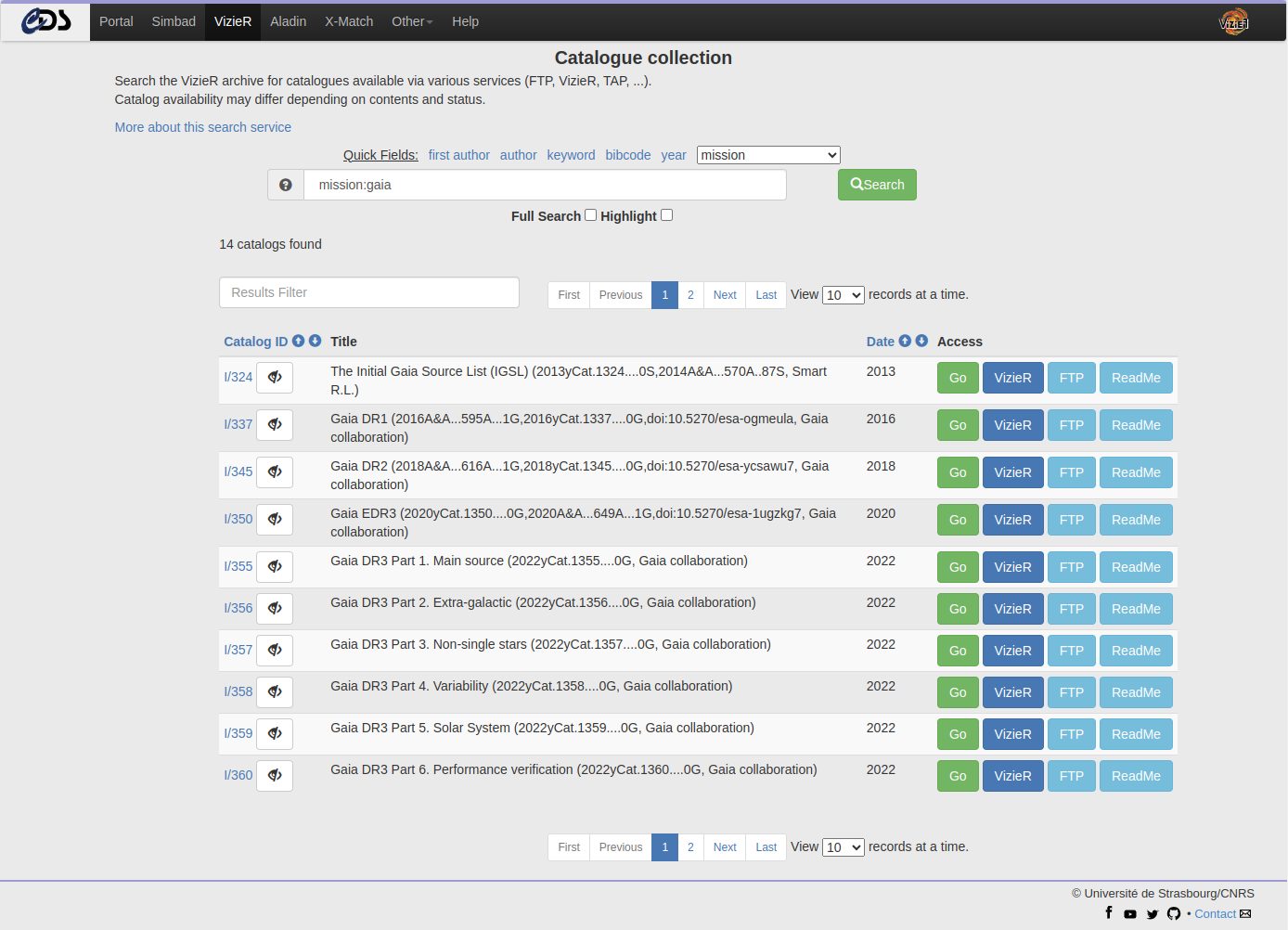Why distribute your data through VizieR?
Last updated on 2023-09-14 | Edit this page
Estimated time: 2 minutes
Overview
Questions
- What is VizieR?
- What is a VizieR catalogue?
- How is VizieR interoperable?
Objectives
- Describe the contents of a VizieR catalogue
- List some VO tools interoperable with VizieR catalogues
- Outline the benefits of submitting your data to VizieR
What is VizieR?
VizieR provides the most complete library of published astronomical catalogues - tables and associated data - with verified and enriched data, accessible via multiple interfaces. Query tools allow the user to select relevant data tables and to extract and format records matching given criteria. Currently, ~ 24 000 catalogues are available (as in August 2023).
Interactive window: VizieR homepage webpage. Note that you can type in (it is not an image).
VizieR was initially started as a joint effort of CDS (Centre de Données astronomiques de Strasbourg) and ESA-ESRIN (Information Systems Division), and is now fully managed by CDS. VizieR has been available since 1996, and was described in a paper published in 2000 (DOI: 10.1051/aas:2000169).
Note that VizieR does not contain all available online catalogues: some catalogues are not suitable and some less frequently used catalogues have not yet been incorporated into the VizieR database. The full list of catalogues is available from there: Catalogue collection page.

VizieR and more generally speaking the CDS are quite involved in the data preservation aspect, as evidenced by the DSA and CTS certifications awarded over the last years. More details on the topic can be found at the page below.
Interactive window: CDS webpage related to the CoreTrustSeal certification.
What is a VizieR catalogue?
We call a VizieR catalogue:
- A set of documented tables (including a ReadMe file), linked to a published paper
- With an indexation by keywords, authors, date, UCDs …
- With a global indexation by position whenever possible
- And citation capability (bibcode or DOI)
A catalogue can optionally contains other data types, also associated with publications. Here is a non exhaustive list:
- Photometric information: this will populate the VizieR SED service
- FITS Spectra, images and cubes: this will populate the associated Saada/VizieR database
- Time series and spectra: they will be displayed as interactive plot (see example of interactive time serie plot)
- Table of references (see example of refs.dat file)
- Time measurements: this allows for time comparisons, for example with Time MOCs in Aladin
- Solar system information: it will be added to the VizieR B/planets catalogue and populate the VESPA site
Interactive window: VizieR catalogue landing page, example for Gaia DR3 Part 1 (VizieR name: I/355).
VizieR catalogue and CDS tools
Once a catalogue is ingested in VizieR, one can access a range of tools:
- Query the VizieR table(s)
- Access to the FTP (archived VizieR tables as described by the ReadMe)
- Query VizieR table(s) using TAP/SQL
- Perform a fast cross-match identification between VizieR tables or Simbad
- Load your tables in Aladin
- Plot photometry (“SED”) including all VizieR
- Query VizieR associated data
(images, spectra)
- Query all VizieR catalogues using CDS Python package
- VizieR tables with astronomical objects can be processed in SIMBAD.

Why distribute your data through VizieR?
In addition to the interoperability with the VO tools mentioned above, distributing your data through VizieR means adding values to them.
- Step in search engine:
- VO Registries: CDS Registry, IVOA Registry of Registries (RofR)
- Eudat
- Astrophysics Data System (ADS)
- European Open Science Cloud (EOSC) Portal
- Step in the VO: interoperability with other tools, e.g.
- Load your data as a VO Table using TOPCAT
- Visualize a spectrum using CASSIS
- Analyze a spectrum using Splat
- Analyze your data using astroquery
- Added metadata:
- UCD (VO)
- Keywords (UAT)
- Protocol (ADQL)
- DOI (Citation)
- Bibcode
- MOC
Summary: Benefits of using VizieR
Distribute your data in a trusted repository in accordance with Open Data principles
- Data preservation: The CDS has been awarded the Core Trust Seal.
-
Discovery: Take advantage of the VizieR services
allowing for the discovery, and a good data visibility
- Dedicated indexations
- Quality and a good data description
- Generate persistent identifier (bibcode, DOI) for citation
- Data are available through the Virtual Observatory (VO) services
- Data can be queried by various means (simple search, TAP, Python …) and retrieved in different format (ASCII, Fits, VOTable …)
Next chapters
In the next chapters, you will learn what type of data can be submitted, how to prepare and submit them to VizieR, and finally how to search your data using the EOSC tools.
